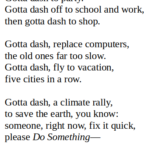Going Organic
Going organic is much more than just switching from Monsanto-manufactured chemical warfare, to herbal sprays and less-toxic powders. Going organic is an opportunity to rethink. It is a journey of rebuilding with different, yet similar, basic components.
When we build our garden organically, we must leave behind the grow-what-I-wish-and-spray-the-bad-bugs domination mentality. There is a whole ecosystem out there which synthetic-chemical gardening techniques ignore and motor over. Going organic is an opportunity to step into that ecosystem and to embrace it, and to nudge it into being useful for your ends, in other words for growing human food.
By “ecosystem,” I mean that we aren’t just growing veggies, herbs, flowers, and trees. We’re also growing soil, beneficial insects, fresh air, and wildlife. We must consider these in the full picture of our system.
When we see a bug munching our veggies, If we merely reach for a spray – synthetic chemical or less-toxic, it doesn’t matter – we are overlooking many other possibilities. Bill Mollison, co-founder of the Permaculture theory, is often quoted as saying “You don’t have a snail problem, you have a duck deficiency.” Increase your duck population and you will have less slugs. He’s inviting you to shift perspective: perhaps the solution is not annihilation; perhaps your system needs the addition of a missing element.
In synthetic-chemical gardening, one uses a myriad of sprays and powders. There’s a chemical that can be applied to just about every problem. An organic gardener has many tools she can use, only a few of which are sprays, and very few of which fit the “applied to” verb form. In fact, she often approaches a problem situation from many angles simultaneously. And most of those angles involve shoring up a faltering portion of the overall cycle or system.
Newcomers to organic gardening frantically seek recipes for homemade sprays and powders. Instead, have you looked into beneficial insects, pheromone lures, physical traps, barrier methods? Look up your bugs online and see what might eat them. I often do this by searching Google until I can positively identify my bug, getting its scientific name, and then searching for that name plus the word “predator.” You can buy many beneficial and predator bugs through catalogs like Gardens Alive, Planet Natural and others.
Many plant disabilities can be traced back to soil deficiencies. Have a soil analysis done. If you are new to the organic world, likely your soil is not in tip-top shape. All gardening begins with building healthy soil. More than just feeding your soil this season, what can be done to assure that your soil continues to get what it needs on an ongoing basis? Learn about mulching, sheet composting, use of legumes, mycorrhizae, and water-wise techniques appropriate to your area.
Do not overlook what veterans have to say about plant rotation. Much of the folk wisdom about plant rotation has to do with the fact that plant diseases can become resident in the soil. How many gardeners insist “I always grow my tomatoes there!” The same family of crop grown in the same spot year after year is asking for trouble. Poor soil nutrients can only compound this issue because weakened, undernourished plants are much more susceptible to pests.
Plant selection is also very important. From the outset, select species and varieties that are likely to do well in your specific area. Check the internet. Check locally written garden books. What does this plant like? Sun, shade, drought, marsh, low nutrients, high humus? What time of year do I plant it? Do others in my area grow it successfully?
Pay attention to the plant’s origin (example: forest floor) as this indicates what it has evolved to need. Is there a variety of it that is already adapted to my area (example: drought-resistant varieties of conventional, previously English, veggies). Is there a variety that is resistant to the plant diseases I am encountering (note the abbreviations by each variety of tomato in a given catalog).
Seed saving from your successes can also help, because what did well on YOUR plot last year might be the best adaptation for your plot this year. Expecting to grow a plant in marginal conditions is asking for a high-maintenance gardening project. Far better to select plants that are comfy where and how you plan to grow them.
Going organic is a glowing and beckoning invitation to get to know your individual plot of land; to get up close and personal and also to step back and see it in a broader picture. Hello, Garden-Plot, who are you? Like you’d get to know a significant other, get to know your land. Beyond “what zone am I” there are bigger questions:
- Am I in a drought area? Look at the past 5-10 years, and at climate change forecasts, don’t merely look at the 100 year history.
- What is the history of my land? Conventional, and thus depleted, farmland? Topsoil scalped for new housing development?
- Where are my permanent shade zones? (example: behind the garage wall)
- What areas of my land won’t drain (or conversely don’t have irrigation)?
- What critters live here besides me, that I will have to figure out how to cope with?
Organic is far more than leaving behind the toxic chemicals. It includes getting to know your plot of earth and its particular circumstances, and matching this with the needs of the plant you’re proposing to grow. Getting to know your local bugs and who eats whom. Getting to know what critters like to live on your property and figuring out how you can coexist with them. And yes, you may learn to cook up a few little herbal brews that might be sprayed as a band-aid once in a while. But sprays and applied-stuff are far from the mainstay of a vital and bountiful organic garden.
This is a lot to think about, and won’t really help with your corn plants this spring. But it will help you with your overall approach to gardening. Also, it’s something that most of us ease into over time, so you can’t kick yourself for not knowing all from the very beginning. Rather, it is a glimpse of the journey ahead.
Return to Table of Contents


